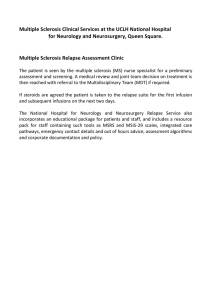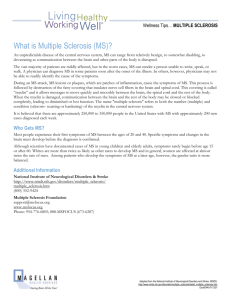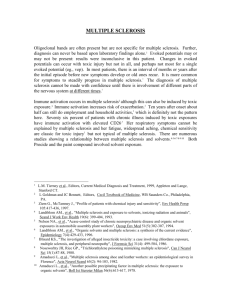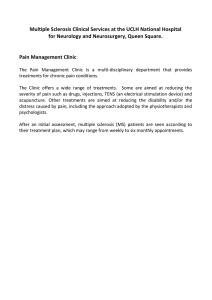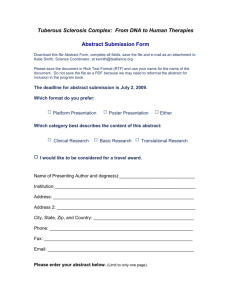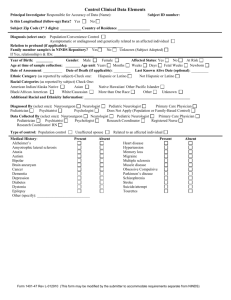Appendix B NATIONAL INSTITUTE FOR HEALTH AND CARE EXCELLENCE
advertisement
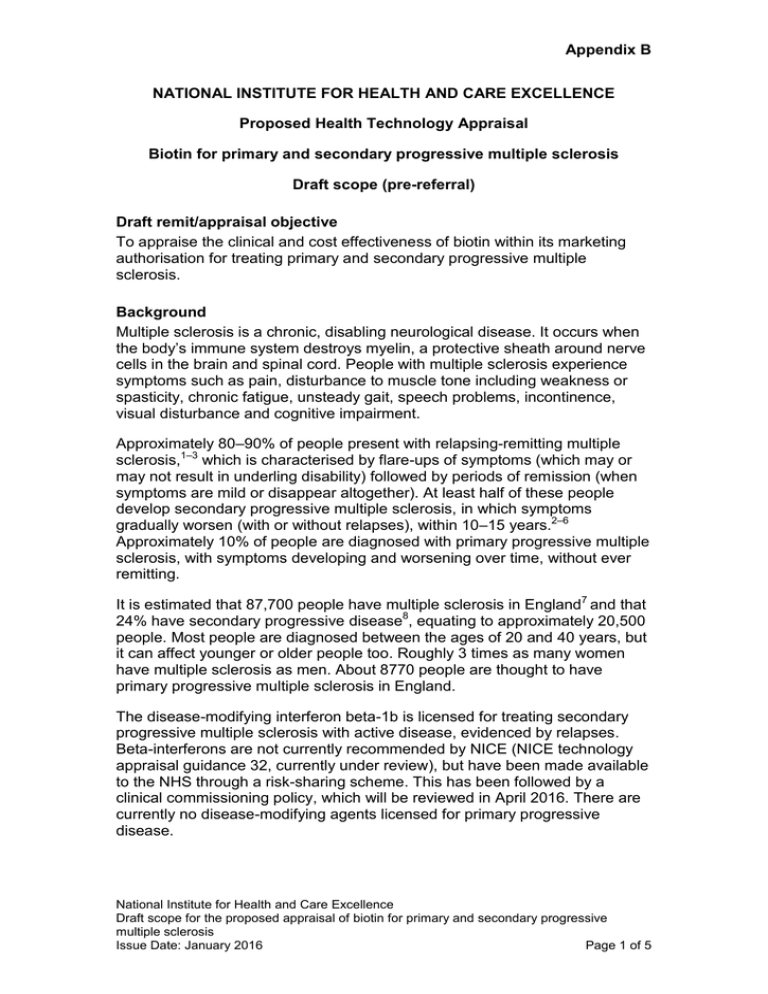
Appendix B NATIONAL INSTITUTE FOR HEALTH AND CARE EXCELLENCE Proposed Health Technology Appraisal Biotin for primary and secondary progressive multiple sclerosis Draft scope (pre-referral) Draft remit/appraisal objective To appraise the clinical and cost effectiveness of biotin within its marketing authorisation for treating primary and secondary progressive multiple sclerosis. Background Multiple sclerosis is a chronic, disabling neurological disease. It occurs when the body’s immune system destroys myelin, a protective sheath around nerve cells in the brain and spinal cord. People with multiple sclerosis experience symptoms such as pain, disturbance to muscle tone including weakness or spasticity, chronic fatigue, unsteady gait, speech problems, incontinence, visual disturbance and cognitive impairment. Approximately 80–90% of people present with relapsing-remitting multiple sclerosis,1–3 which is characterised by flare-ups of symptoms (which may or may not result in underling disability) followed by periods of remission (when symptoms are mild or disappear altogether). At least half of these people develop secondary progressive multiple sclerosis, in which symptoms gradually worsen (with or without relapses), within 10–15 years.2–6 Approximately 10% of people are diagnosed with primary progressive multiple sclerosis, with symptoms developing and worsening over time, without ever remitting. It is estimated that 87,700 people have multiple sclerosis in England7 and that 24% have secondary progressive disease8, equating to approximately 20,500 people. Most people are diagnosed between the ages of 20 and 40 years, but it can affect younger or older people too. Roughly 3 times as many women have multiple sclerosis as men. About 8770 people are thought to have primary progressive multiple sclerosis in England. The disease-modifying interferon beta-1b is licensed for treating secondary progressive multiple sclerosis with active disease, evidenced by relapses. Beta-interferons are not currently recommended by NICE (NICE technology appraisal guidance 32, currently under review), but have been made available to the NHS through a risk-sharing scheme. This has been followed by a clinical commissioning policy, which will be reviewed in April 2016. There are currently no disease-modifying agents licensed for primary progressive disease. National Institute for Health and Care Excellence Draft scope for the proposed appraisal of biotin for primary and secondary progressive multiple sclerosis Issue Date: January 2016 Page 1 of 5 Appendix B The technology Biotin (Cerenday, Medday Pharmaceuticals) is a water-soluble vitamin, which in high-dose formulations, acts as a co-enzyme for carboxylases involved in key steps of energy metabolism and fatty acid synthesis. High doses of biotin may promote myelin repair, and enhance energy production in demyelinated neurons. Biotin is administered orally. Biotin does not currently have a marketing authorisation in the UK for multiple sclerosis. It has been studied in clinical trials, compared with placebo, in adults with primary or secondary progressive multiple sclerosis. Intervention(s) Biotin Population(s) People with primary or secondary progressive multiple sclerosis Comparators For primary progressive multiple sclerosis: Established clinical management without diseasemodifying agents For secondary progressive multiple sclerosis in people with active disease, evidenced by relapses, and where the eligibility criteria for treatment under the clinical commissioning policy are met: Beta interferon-1b For secondary progressive multiple sclerosis in people without active disease or where the eligibility criteria under the clinical commissioning policy are not met: Outcomes Established clinical management without diseasemodifying agents The outcome measures to be considered include: disability (for example, expanded disability status scale [EDSS] or time to walk 25 feet) symptoms of multiple sclerosis (such as fatigue, cognition and visual disturbance) relapse rate severity of relapse freedom from disease activity mortality adverse effects of treatment health-related quality of life. National Institute for Health and Care Excellence Draft scope for the proposed appraisal of biotin for primary and secondary progressive multiple sclerosis Issue Date: January 2016 Page 2 of 5 Appendix B Economic analysis The reference case stipulates that the cost effectiveness of treatments should be expressed in terms of incremental cost per quality-adjusted life year. The reference case stipulates that the time horizon for estimating clinical and cost effectiveness should be sufficiently long to reflect any differences in costs or outcomes between the technologies being compared. Costs will be considered from an NHS and Personal Social Services perspective. Other considerations If the evidence allows subgroups of people with primary or secondary progressive multiple sclerosis will be considered. Guidance will only be issued in accordance with the marketing authorisation. Where the wording of the therapeutic indication does not include specific treatment combinations, guidance will be issued only in the context of the evidence that has underpinned the marketing authorisation granted by the regulator. Related NICE recommendations and NICE Pathways Related technology appraisals: ‘Beta interferon and glatiramer acetate for the treatment of multiple sclerosis’ (2002). NICE Technology Appraisal 32. Currently under review [ID809]; publication expected April 2017. Related Guidelines: ‘Management of multiple sclerosis in primary and secondary care’ (2014). NICE guideline 186. Review date December 2016. Related Interventional Procedures: ‘Percutaneous venoplasty for chronic cerebrospinal venous insufficiency for multiple sclerosis’ (2012). NICE interventional procedures guidance 420. Review date to be confirmed. Related National Policy NHS England Clinical Commissioning Policy: Disease Modifying Therapies for Patients with Multiple Sclerosis (MS) (May 2014). Department of Health The Risk Sharing Scheme for Disease Modifying Therapies in MS (January 2011). Department of Health NHS Outcomes Framework 20152016 (December 2014) Domains 1– 4. National Institute for Health and Care Excellence Draft scope for the proposed appraisal of biotin for primary and secondary progressive multiple sclerosis Issue Date: January 2016 Page 3 of 5 Appendix B Questions for consultation Would biotin be considered for use in people with active disease? Have all relevant comparators for biotin been included in the scope? How should established clinical management without disease-modifying agents for primary and secondary progressive multiple sclerosis be defined? Are the subgroups suggested in ‘other considerations appropriate? Are there any other subgroups of people in whom biotin is expected to be more clinically effective and cost effective or other groups that should be examined separately? Where do you consider biotin will fit into the existing NICE pathway for multiple sclerosis? Have all relevant outcomes for primary and secondary progressive multiple sclerosis been included in the scope? Do outcome assessments in primary and secondary progressive multiple sclerosis differ from assessments in relapsing-remitting disease? NICE is committed to promoting equality of opportunity, eliminating unlawful discrimination and fostering good relations between people with particular protected characteristics and others. Please let us know if you think that the proposed remit and scope may need changing in order to meet these aims. In particular, please tell us if the proposed remit and scope: could exclude from full consideration any people protected by the equality legislation who fall within the patient population for which biotin will be licensed; could lead to recommendations that have a different impact on people protected by the equality legislation than on the wider population, e.g. by making it more difficult in practice for a specific group to access the technology; could have any adverse impact on people with a particular disability or disabilities. Please tell us what evidence should be obtained to enable the Committee to identify and consider such impacts. Do you consider biotin to be innovative in its potential to make a significant and substantial impact on health-related benefits and how it might improve the way that current need is met (is this a ‘step-change’ in the management of the condition)? National Institute for Health and Care Excellence Draft scope for the proposed appraisal of biotin for primary and secondary progressive multiple sclerosis Issue Date: January 2016 Page 4 of 5 Appendix B Do you consider that the use of biotin can result in any potential significant and substantial health-related benefits that are unlikely to be included in the QALY calculation? Please identify the nature of the data which you understand to be available to enable the Appraisal Committee to take account of these benefits. NICE intends to appraise this technology through its Single Technology Appraisal (STA) Process. We welcome comments on the appropriateness of appraising this topic through this process. (Information on the Institute’s Technology Appraisal processes is available at http://www.nice.org.uk/article/pmg19/chapter/1-Introduction) References 1 Murray TJ (2006) Diagnosis and treatment of multiple sclerosis. British Medical Journal 332: 525–7 2 NHS Choices website. Multiple sclerosis - overview [accessed July 2015] 3 Patient.co.uk Multiple sclerosis health information [accessed July 2015] 4 National Institute for Health and Care Excellence (2014) Management of multiple sclerosis in primary and secondary care NICE guideline (CG186) 5 Rovaris M, Confavreux C, Furlan R et al. (2006) Secondary progressive multiple sclerosis: current knowledge and future challenges. The Lancet 5: 343–54 6 Multiple Sclerosis Society (2014) Secondary Progressive MS [accessed July 2015] 7 Multiple Sclerosis Society (2014) MS in the UK [accessed July 2015] 8 Information provided by the company (Biogen) National Institute for Health and Care Excellence Draft scope for the proposed appraisal of biotin for primary and secondary progressive multiple sclerosis Issue Date: January 2016 Page 5 of 5
